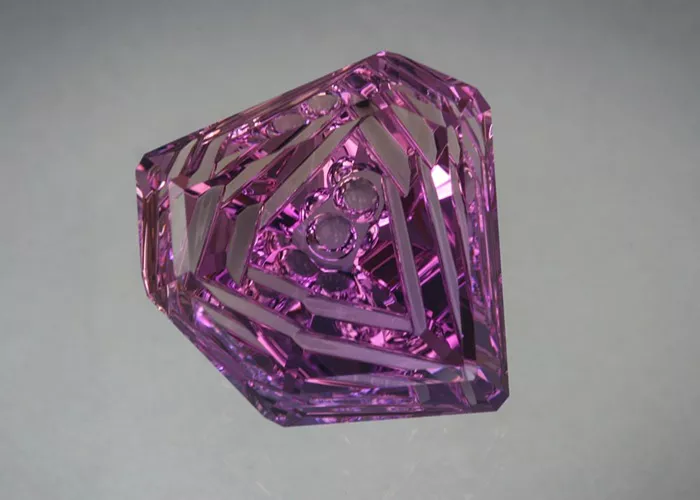One gemstone that is often perceived as being cheap or affordable is amethyst. While amethyst is a beautiful and popular gemstone, it is often priced lower than other gemstones with similar properties. In this article, I will explain from a professional perspective why amethyst is so cheap, including its abundance, availability, and market demand.
Abundance of Amethyst
Amethyst is a variety of quartz that is found in many parts of the world. It is a relatively common mineral, and large deposits of amethyst can be found in Brazil, Uruguay, and Zambia, among other countries. This abundance of amethyst means that it is readily available and easy to source, which can contribute to its lower price point.
Availability of Amethyst
In addition to its abundance, amethyst is also widely available in the jewelry market. It is a popular gemstone for both fine and fashion jewelry, and can be found in a variety of settings and styles. This availability means that there is a high supply of amethyst in the market, which can contribute to its lower price point.
Market Demand for Amethyst
While amethyst is a popular gemstone, it does not have the same level of market demand as other gemstones such as diamond or ruby. This lower demand can also contribute to its lower price point. Additionally, amethyst is often used as a secondary stone in jewelry designs, rather than a primary stone. This means that it is not typically the focus of a jewelry piece, which can also contribute to its lower price point.
Quality and Grading of Amethyst
It is also important to note that the price of amethyst can vary depending on its quality and grading. Higher quality amethyst, with a deeper and more saturated color and fewer inclusions, can be priced higher than lower quality amethyst. Additionally, amethyst that has been treated to enhance its color or clarity can also be priced higher.
What is the reason for the sharp drop in amethyst prices?
There are many reasons for the sharp drop in amethyst prices, and here are some possible reasons:
Overexploitation: Excessive production of amethyst may lead to oversupply in the market, resulting in a decline in prices.
Market demand decline: The demand for amethyst in the market may decrease due to economic conditions, consumer trends, or other factors, leading to a price drop.
Poor quality: Low quality amethysts may lead to a drop in overall market prices, as their presence may affect consumers’ overall impression of amethysts.
Origin competition: Competition between amethyst origins may lead to price drops as they attempt to gain a larger market share.
The emergence of substitutes: The emergence of substitutes may lead to a decrease in demand for amethyst, resulting in a price drop.
It should be noted that these factors are not independent and may interact with each other, leading to changes in the price of amethyst.
Does the low price of amethyst mean low quality?
The low price of amethyst does not necessarily mean low quality. Although the price of amethyst is usually influenced by its quality, it is also affected by various factors such as market supply and demand, fashion trends, and origin. Therefore, a low price does not necessarily mean poor quality of amethyst.
In fact, the quality of amethyst is determined by various factors, including color, transparency, purity, cutting, and shape. Low priced amethysts may be due to excessive production or low market demand, rather than their poor quality. Similarly, high priced amethysts may not necessarily represent high quality, as prices are also influenced by factors such as supply and demand and market trends.
Therefore, if you want to purchase amethyst, it is best to understand its quality and market price before making a wise decision.
Does the price of amethysts reflect their actual value?
The price of amethysts does not necessarily reflect their actual value. Although the price of amethyst in the market is usually influenced by factors such as quality, scarcity, and fashion trends, these factors do not necessarily reflect the actual value of amethyst.
In fact, the value of amethyst is determined by various factors, including its uniqueness, historical background, cultural significance, spiritual effects, and therapeutic effects. For example, amethyst was considered a gemstone with mysterious powers in ancient times, used to treat physical and mental problems. It is also considered a gemstone that can balance emotions, enhance intuition, strengthen the immune system, and promote physical health.
Therefore, the actual value of amethyst may far exceed its market price. If you are interested in amethyst, it is best to learn about its history, culture, and therapeutic effects in order to better understand its practical value.
Conclusion
In conclusion, amethyst is a beautiful and popular gemstone that is often priced lower than other gemstones with similar properties. This is due to its abundance, availability, and lower market demand compared to other gemstones. However, it is important to note that the price of amethyst can vary depending on its quality and grading, and that treated amethyst can be priced higher. As a jewelry appraiser, it is my responsibility to educate my clients on the value and pricing of different gemstones, including amethyst, so that they can make informed decisions about their jewelry purchases.
Related topic:


